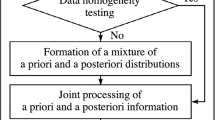Abstract
After defining the term standardization the necessity of standardized planning, execution, and evaluation in quantitative analysis is illustrated. From the working steps: sampling, preliminary treatment of the sample, determination, and evaluation only the last two steps are standardizable in an universal way, because they can be examined and checked up independently from the actual object of inquiring. These steps are designated as analytical procedure in a narrow meaning. The quantitative analytical message is obtained by way of a chain of signal S, information I, and of an absolute quantity of the determinated substance, called working quantity A. The transitions should be described by a signal function I=f(S) and by an analytical function A=F(I). The important demand for a standard procedure is the realization of a lineary analytical function in a defined working range. A classification of standard working ranges as “complete” ranges of powers of ten for amounts of substances in the SI-unit Mol leads to new general designations for all kinds of analytical procedures. By fixing a general scheme of measurement execution and result evaluation an identically set of characteristic data can be obtained for a critical examination and an objective comparison of procedures. The base of the standard evaluation is the method of least squares, applicated to a set of 24 blocks of data arranged in standardized 6 groups of a size of 4 blocks. Details of standard measurements and standard evaluation are presented in paper II.
Zusammenfassung
Nach Definition des Begriffes Standardisierung wird die Notwendigkeit einer standardisierten Planung, Durchführung und Auswertung in der quantitativen Analytik erläutert. Von den Arbeitsstufen: Probenahme, Probenvorbehandlung, Bestimmung und Auswertung sind nur die letzten beiden Stufen universell standardisierbar, da sie unabhängig vom aktuellen Untersuchungsobjekt betrachtet und getestet werden können. Diese Stufen werden im engeren Sinne als Analysenverfahren bezeichnet. Die quantitative analytische Nachricht wird über eine Kette von Signal S, Information I und einer absoluten Menge der bestimmten Substanz, der Arbeitsmenge A, erhalten. Die Übergänge sollten durch eine Signalfunktion I=f(S) und eine Analysenfunktion A =F(I) beschrieben werden. Die wichtigste Forderung für ein Standardverfahren ist die Realisierung einer linearen Analysenfunktion in einem definierten Arbeitsbereich. Eine Klassifizierung von Standard-Arbeitsbereichen als „glatte“ Zehnerpotenzbereiche von Stoffmengen in der SI-Einheit Mol führt zu neuen allgemeinen Bezeichnungen für alle Arten von Analysenverfahren. Durch Festlegung eines allgemeinen Schemas der Meßdurchführung und Resultatauswertung kann ein gleichartiger Satz von Kenndaten zur kritischen Beurteilung und zum objektiven Vergleich von Verfahren erhalten werden. Die Grundlage der Standard-Auswertung ist die Methode der kleinsten Abweichungsquadrate, angewendet auf 24 Datenblöcke, die in standardisierter Form zu 6 Gruppen vom Umfang 4 angeordnet sind. Einzelheiten zu den Standard-Messungen und zur Standard-Auswertung werden im Teil II gebracht.
Similar content being viewed by others
Literatur
Kaiser, H.: diese Z. 260, 252 (1972)
Knecht, J.: diese Z. 270, 97 (1974)
Systemtheorie in der Analytik. I. Definition und Interpretation systemtheoretischer Grundbegriffe. Diese Z. 256, 257 (1971); englische Version: Talanta 20, 811 (1973)
Systemtheorie in der Analytik. II. System der analytischen Mengenbereiche. Diese Z. 261, 1 (1972)
Author information
Authors and Affiliations
Rights and permissions
About this article
Cite this article
Gottschalk, G. Standardisierung quantitativer Analysenverfahren. Z. Anal. Chem. 275, 1–10 (1975). https://doi.org/10.1007/BF00432989
Received:
Issue Date:
DOI: https://doi.org/10.1007/BF00432989




